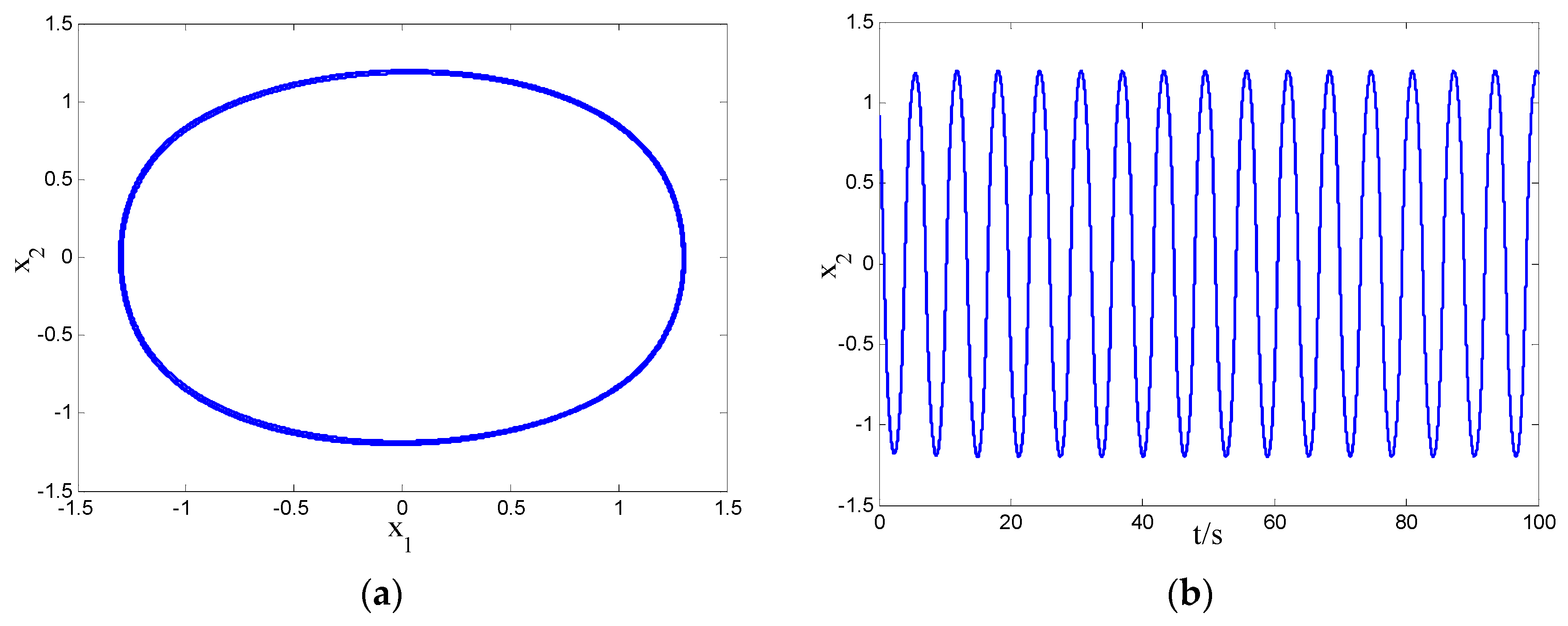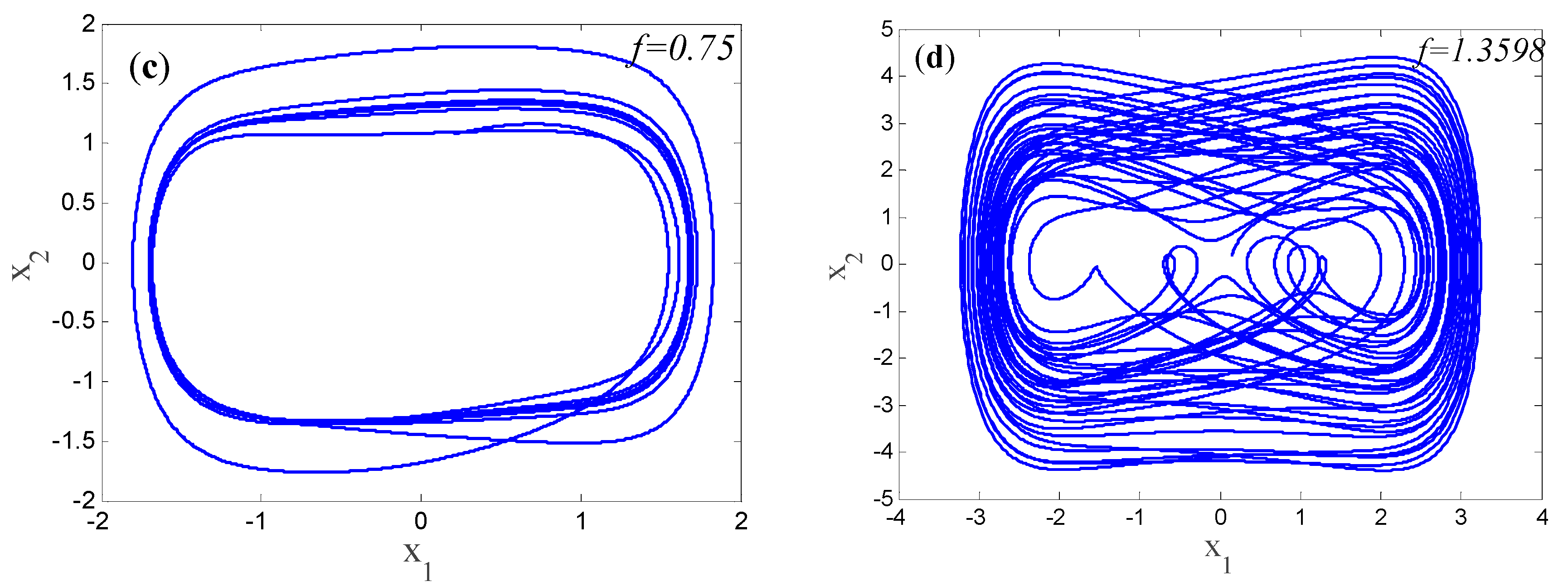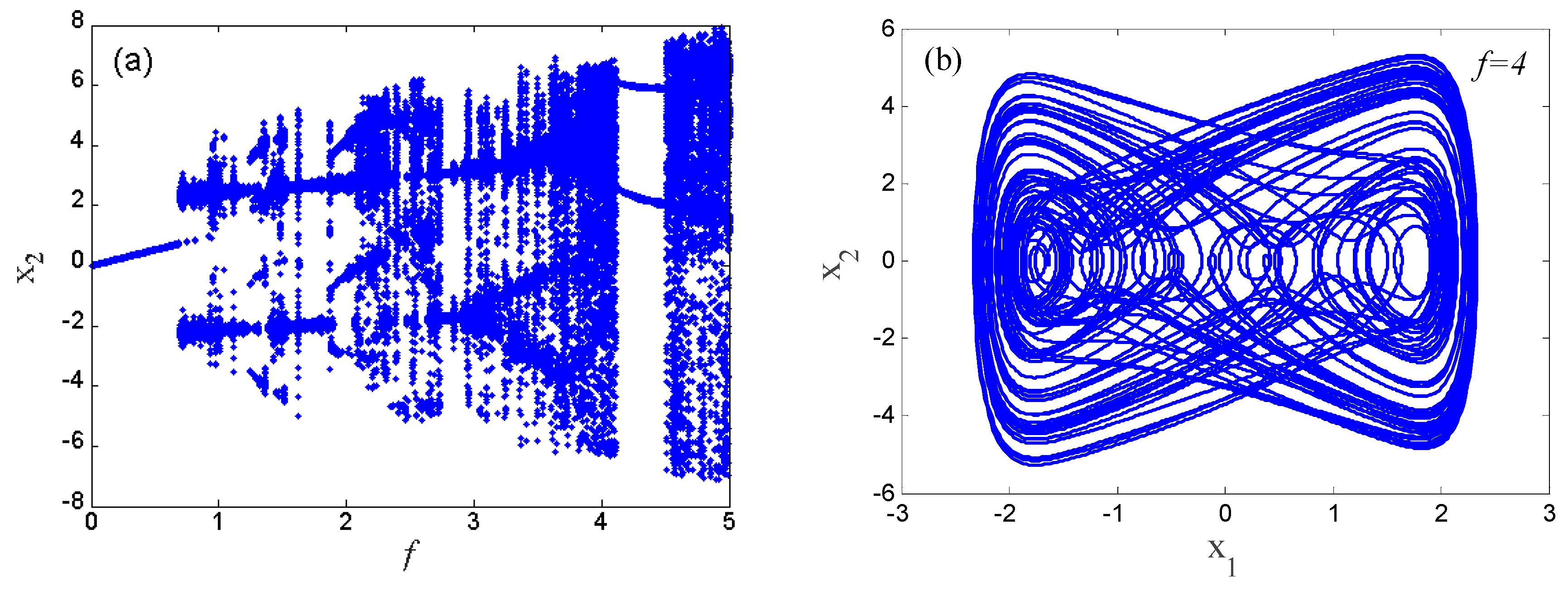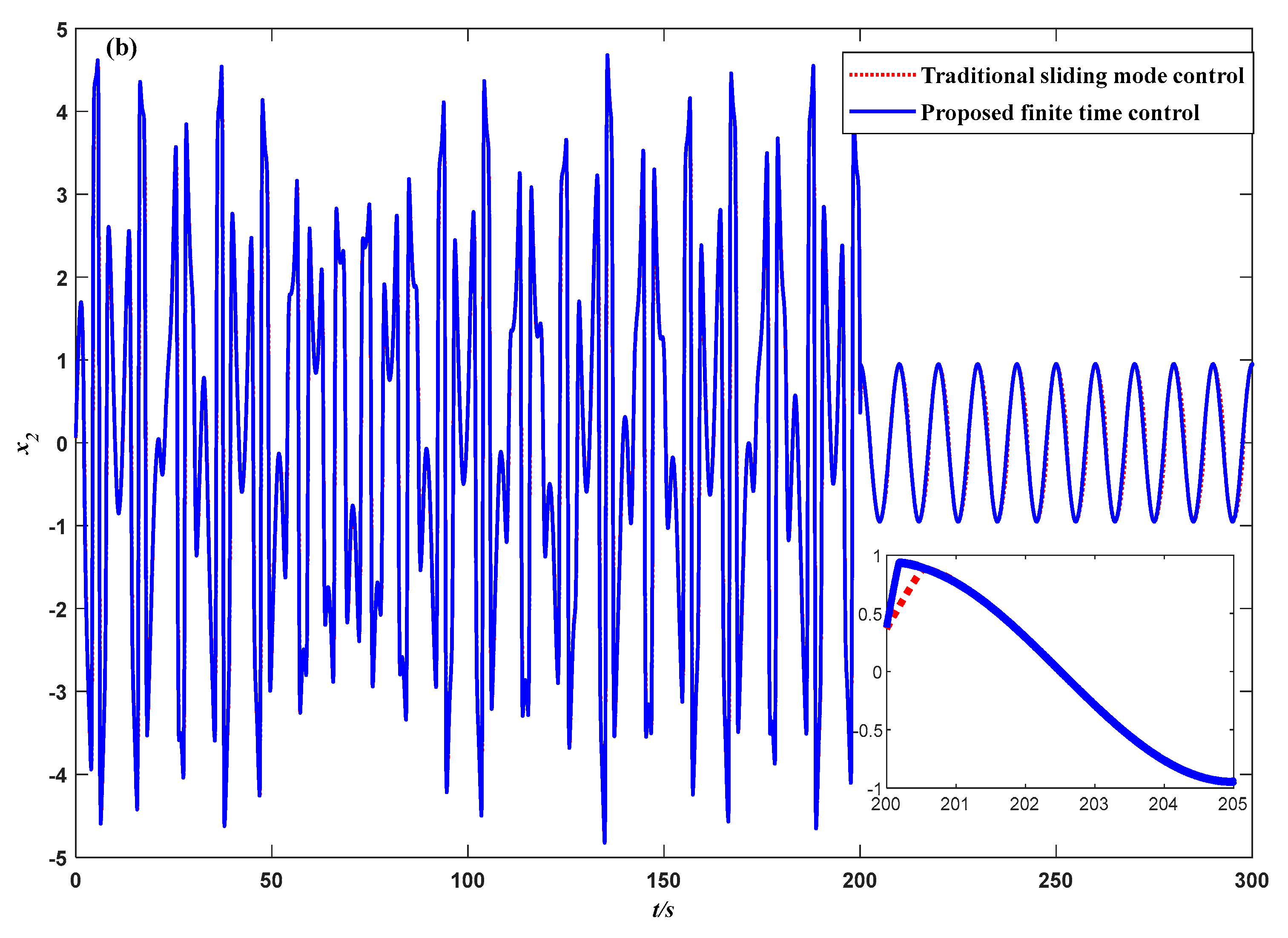Dynamic Analysis and Suppression Strategy Research on a Novel Fractional-Order Ferroresonance System
Abstract
:1. Introduction
- (1)
- A typical 110 kV ferroresonance model is firstly established. The chaotic mechanism of the ferroresonance system and the influence of the excitation amplitude are analyzed comprehensively.
- (2)
- Based on the fractional calculus theory, a novel fractional-order ferroresonance model is established. The effects of the fractional order and the order of flux chain on the motion state of the system are studied through bifurcation diagrams and phase portraits.
- (3)
- By means of finite-time theory and the frequency distributed model, a novel fractional-order fast terminal sliding mode control method is proposed, which will solve the stabilization and tracking issue for the fractional-order ferroresonant system with uncertainties and disturbances.
2. Modeling and Analysis of the Ferroresonance System
2.1. The Chaotic Mechanism
2.2. Excitation Amplitude Effects
3. Dynamic Analysis of the Fractional-Order Ferroresonance System
4. Design of a Fractional-Order Finite-Time Sliding Mode Controller
4.1. The Frequency Distributed Model
4.2. Finite-Time Control
- (1)
- represents the monotonic Lyapunov function about fundamental frequency ;
- (2)
- represents the Lyapunov function, which is the sum of the products of all weighting functions and monotonic function ;
4.3. Simulation and Comparison
5. Conclusions and Discussion
- (1)
- The increase in the external excitation amplitude will expand the resonance region and unstable region of the ferromagnetic resonance system, and it is easy to enter the chaotic state and destroy the system structure caused by safety accidents.
- (2)
- Fractional calculus is introduced into the modeling and analysis of the system, which has higher degrees of freedom and more accurate physical characteristics. With the increase in the order of the flux chain, more complex nonlinear dynamic behaviors are obtained, and the factors affecting the ferromagnetic resonance should be more precise.
- (3)
- As for the suppression strategy of chaotic oscillation, by using the frequency distribution model, the fractional-order model is transformed into an integer-order model. Based on the finite-time method and Lyapunov stability theory, an innovative fractional-order sliding mode controller is designed to realize the stability of the system in finite time, considering the uncertainties of the model and the external disturbances. Compared with the traditional sliding mode method, the effectiveness and superiority of the designed controller are confirmed by the simulation results.
Author Contributions
Funding
Data Availability Statement
Acknowledgments
Conflicts of Interest
References
- Perez Pineda, R.; Rodrigues, R.; Aguila Tellez, A. Analysis and Simulation of Ferroresonance in Power Transformers using Simulink. Rev. IEEE América Lat. 2018, 16, 460–466. [Google Scholar] [CrossRef]
- Arroyo, A.; Martinez, R.; Manana, M.; Pigazo, A.; Minguez, R. Detection of ferroresonance occurrence in inductive voltage transformers through vibration analysis. Int. J. Electr. Power Energy Syst. 2019, 106, 294–300. [Google Scholar] [CrossRef]
- Bera, P.K.; Isik, C.; Kumar, V. Discrimination of Internal Faults and Other Transients in an Interconnected System With Power Transformers and Phase Angle Regulators. IEEE Syst. J. 2021, 15, 3450–3461. [Google Scholar] [CrossRef]
- Heidary, A.; Rouzbehi, K.; Radmanesh, H.; Pou, J. Voltage Transformer Ferroresonance: An Inhibitor Device. IEEE Trans. Power Deliv. 2020, 35, 2731–2733. [Google Scholar] [CrossRef]
- Liu, H.; Li, Q.; Sui, Y.; Liu, L.; Liu, H. Research on the mechanism and restraining measures of ferroresonance in distribution network based on ATP-EMTP. Electr. Power Syst. Res. 2023, 223, 109561. [Google Scholar] [CrossRef]
- Rezaei, S.; Aref, S.; Anaraki, A.S. A review on oscillations in Wind Park due to ferroresonance and subsynchronous resonance. IET Renew. Power Gener. 2021, 15, 3777–3792. [Google Scholar] [CrossRef]
- Wang, B.; Zhang, C.; Xia, Y.; Zhang, F. Analytical solution of serial ferroresonance triggered by circuit breaker operation in solidly grounded power grids. Int. J. Electr. Power Energy Syst. 2023, 154, 109447. [Google Scholar] [CrossRef]
- Pal, R.S.; Roy, M. Verification of Period-Doubling Behavior of Ferroresonance Circuit with the Jacobian Matrix and Eigenvalues. J. Inst. Eng. (India) Ser. B 2023, 104, 501–510. [Google Scholar] [CrossRef]
- Djebli, A.; Aboura, F.; Roubache, L.; Touhami, O. Impact of the eddy current in the lamination on ferroresonance stability at critical points. Int. J. Electr. Power Energy Syst. 2019, 106, 311–319. [Google Scholar] [CrossRef]
- Heidary, A.; Radmanesh, H. Smart solid-state ferroresonance limiter for voltage transformers application: Principle and test results. IET Power Electron. 2018, 11, 2545–2552. [Google Scholar] [CrossRef]
- Mikhak-Beyranvand, M.; Faiz, J.; Rezaei-Zare, A.; Rezaeealam, B. Electromagnetic and thermal behavior of a single-phase transformer during Ferroresonance considering hysteresis model of core. Int. J. Electr. Power Energy Syst. 2020, 121, 106078. [Google Scholar] [CrossRef]
- Zou, M. Accurate simulation model for a three-phase ferroresonant circuit in EMTP–ATP. Int. J. Electr. Power Energy Syst. 2019, 107, 68–77. [Google Scholar] [CrossRef]
- Hidalgo-Reyes, J.; Gómez-Aguilar, J.; Escobar-Jiménez, R.; Alvarado-Martínez, V.; López-López, M. Classical and fractional-order modeling of equivalent electrical circuits for supercapacitors and batteries, energy management strategies for hybrid systems and methods for the state of charge estimation: A state of the art review. Microelectron. J. 2019, 85, 109–128. [Google Scholar] [CrossRef]
- Liang, G.; Hao, J. Analysis and Passive Synthesis of Immittance for Fractional-Order Two-Element-Kind Circuit. Circuits, Syst. Signal Process. 2019, 38, 3661–3681. [Google Scholar] [CrossRef]
- Yang, N.; Xu, C.; Wu, C.; Jia, R.; Liu, C. Fractional-order cubic nonlinear flux-controlled memristor: Theoretical analysis, numerical calculation and circuit simulation. Nonlinear Dyn. 2019, 97, 33–44. [Google Scholar] [CrossRef]
- Petráš, I.; Terpák, J. Fractional Calculus as a Simple Tool for Modeling and Analysis of Long Memory Process in Industry. Mathematics 2019, 7, 511. [Google Scholar] [CrossRef]
- Stefański, T.P.; Gulgowski, J. Electromagnetic-based derivation of fractional-order circuit theory. Commun. Nonlinear Sci. Numer. Simul. 2019, 79, 104897. [Google Scholar] [CrossRef]
- Liao, X.; Ran, M.; Yu, D.; Lin, D.; Yang, R. Chaos analysis of Buck converter with non-singular fractional derivative. Chaos Solitons Fractals 2022, 156, 111794. [Google Scholar] [CrossRef]
- Yang, N.; Han, Y.; Wu, C.; Jia, R.; Liu, C. Dynamic analysis and fractional-order adaptive sliding mode control for a novel fractional-order ferroresonance system. Chin. Phys. B 2017, 26, 74–86. [Google Scholar] [CrossRef]
- Radmanesh, H.; Gharehpetian, G. Ferroresonance suppression in power transformers using chaos theory. Int. J. Electr. Power Energy Syst. 2013, 45, 1–9. [Google Scholar] [CrossRef]
- Fordoei, H.A.; Heydari, H.; Afsari, S. Elimination of chaotic ferroresonance in power transformer by ISFCL. Int. J. Electr. Power Energy Syst. 2015, 68, 132–141. [Google Scholar] [CrossRef]
- Kraszewski, W.; Syrek, P.; Mitoraj, M. Methods of Ferroresonance Mitigation in Voltage Transformers in a 30 kV Power Supply Network. Energies 2022, 15, 9516. [Google Scholar] [CrossRef]
- Yang, M.; Sima, W.; Duan, P.; Zou, M.; Peng, D.; Yang, Q.; Duan, Q. Electromagnetic transient study on flexible control processes of ferroresonance. Int. J. Electr. Power Energy Syst. 2017, 93, 194–203. [Google Scholar] [CrossRef]
- Fordoei, H.R.A.; Gholami, A.; Fathi, S.H.; Abbasi, A. A new approach to eliminating of chaotic ferroresonant in power transformer oscillations. Int. J. Elec Power 2015, 67, 152–160. [Google Scholar] [CrossRef]
- Mosaad, M.I.; Sabiha, N.A. Ferroresonance Overvoltage Mitigation Using STATCOM for Grid-connected Wind Energy Conversion Systems. J. Mod. Power Syst. Clean. 2022, 10, 407–415. [Google Scholar] [CrossRef]
- Mosaad, M.I.; Sabiha, N.A.; Abu-Siada, A.; Taha, I.B.M. Application of Superconductors to Suppress Ferroresonance Overvoltage in DFIG-WECS. IEEE Trans. Energy Convers. 2022, 37, 766–777. [Google Scholar] [CrossRef]
- Rezaei, S. An adaptive bidirectional protective relay algorithm for ferroresonance in renewable energy networks. Electr. Power Syst. Res. 2022, 212, 108625. [Google Scholar] [CrossRef]
- Rojas, R.; Chaves, J.; Tavares, M. Ferroresonance mitigation for the unconventional rural electrification system. Electr. Power Syst. Res. 2023, 223, 109590. [Google Scholar] [CrossRef]
- Yang, J.; Mu, A. Adaptive Fixed Time Control for Generalized Synchronization of Mismatched Dynamical Systems With Parametric Estimations. IEEE Access 2019, 7, 114426–114439. [Google Scholar] [CrossRef]
- Coronel-Escamilla, A.; Gomez-Aguilar, J.F.; Stamova, I.; Santamaria, F. Fractional order controllers increase the robustness of closed-loop deep brain stimulation systems. Chaos Solitons Fractals 2020, 140, 110149. [Google Scholar] [CrossRef] [PubMed]
- Yang, J.; Xiong, J.; Cen, J.; He, W. Finite-time generalized synchronization of non-identical fractional order chaotic systems and its application in speech secure communication. PLoS ONE 2022, 17, e0263007. [Google Scholar] [CrossRef]
- Huang, S.; Zhou, B.; Li, C.; Wu, Q.; Xia, S.; Wang, H.; Yang, H. Fractional-order modeling and sliding mode control of energy-saving and emission-reduction dynamic evolution system. Int. J. Electr. Power Energy Syst. 2018, 100, 400–410. [Google Scholar] [CrossRef]
- Yaghooti, B.; Salarieh, H. Robust adaptive fractional order proportional integral derivative controller design for uncertain fractional order nonlinear systems using sliding mode control. Proc. Inst. Mech. Eng. Part I J. Syst. Control Eng. 2018, 232, 550–557. [Google Scholar] [CrossRef]
- Gai, M.; Cui, S.; Liang, S.; Liu, X. Frequency distributed model of Caputo derivatives and robust stability of a class of multi-variable fractional-order neural networks with uncertainties. Neurocomputing 2016, 202, 91–97. [Google Scholar] [CrossRef]
- Jafari, P.; Teshnehlab, M.; Tavakoli-Kakhki, M. Synchronization and stabilization of fractional order nonlinear systems with adaptive fuzzy controller and compensation signal. Nonlinear Dyn. 2017, 90, 1037–1052. [Google Scholar] [CrossRef]
- Yang, M.; Sima, W.; Chen, L.; Duan, P.; Sun, P.; Yuan, T. Suppressing ferroresonance in potential transformers using a model-free active-resistance controller. Int. J. Electr. Power Energy Syst. 2018, 95, 384–393. [Google Scholar] [CrossRef]
- Huang, S.; Wang, B. Stability and stabilization of a class of fractional-order nonlinear systems for 0 < α < 2. Nonlinear Dyn. 2017, 88, 973–984. [Google Scholar]
- Khanzadeh, A.; Mohammadzaman, I. Comment on “Fractional-order fixed-time nonsingular terminal sliding mode synchronization and control of fractional-order chaotic systems”. Nonlinear Dyn. 2018, 94, 3145–3153. [Google Scholar] [CrossRef]
- Chen, C.; Li, L.; Peng, H.; Yang, Y. Fixed-time synchronization of inertial memristor-based neural networks with discrete delay. Neural Netw. 2019, 109, 81–89. [Google Scholar] [CrossRef] [PubMed]
- Zhang, C.; Xiao, J. Chaotic Behavior and Feedback Control of Magnetorheological Suspension System With Fractional-Order Derivative. J. Comput. Nonlinear Dyn. 2018, 13, 021007. [Google Scholar] [CrossRef]
- Wang, B.; Ding, J.; Wu, F.; Zhu, D. Robust finite-time control of fractional-order nonlinear systems via frequency distributed model. Nonlinear Dyn. 2016, 85, 2133–2142. [Google Scholar] [CrossRef]















| Nomenclature | Symbol | Value | Symbol | Value |
|---|---|---|---|---|
| Sliding mode surface parameters | , | 5, 5 | 0.5 | |
| Tuning parameter | , | 4, 4 | , , | 1.5, 0.6 |
| Upper boundary | , | 0.1, 0.1 | 0.99 | |
| Traditional sliding mode method | , | 5, 5 |
Disclaimer/Publisher’s Note: The statements, opinions and data contained in all publications are solely those of the individual author(s) and contributor(s) and not of MDPI and/or the editor(s). MDPI and/or the editor(s) disclaim responsibility for any injury to people or property resulting from any ideas, methods, instructions or products referred to in the content. |
© 2023 by the authors. Licensee MDPI, Basel, Switzerland. This article is an open access article distributed under the terms and conditions of the Creative Commons Attribution (CC BY) license (https://creativecommons.org/licenses/by/4.0/).
Share and Cite
Yang, J.; Fan, Y.; Mu, A.; Xiong, J. Dynamic Analysis and Suppression Strategy Research on a Novel Fractional-Order Ferroresonance System. Fractal Fract. 2024, 8, 24. https://doi.org/10.3390/fractalfract8010024
Yang J, Fan Y, Mu A, Xiong J. Dynamic Analysis and Suppression Strategy Research on a Novel Fractional-Order Ferroresonance System. Fractal and Fractional. 2024; 8(1):24. https://doi.org/10.3390/fractalfract8010024
Chicago/Turabian StyleYang, Jianxiang, Yiran Fan, Anle Mu, and Jianbin Xiong. 2024. "Dynamic Analysis and Suppression Strategy Research on a Novel Fractional-Order Ferroresonance System" Fractal and Fractional 8, no. 1: 24. https://doi.org/10.3390/fractalfract8010024
APA StyleYang, J., Fan, Y., Mu, A., & Xiong, J. (2024). Dynamic Analysis and Suppression Strategy Research on a Novel Fractional-Order Ferroresonance System. Fractal and Fractional, 8(1), 24. https://doi.org/10.3390/fractalfract8010024






